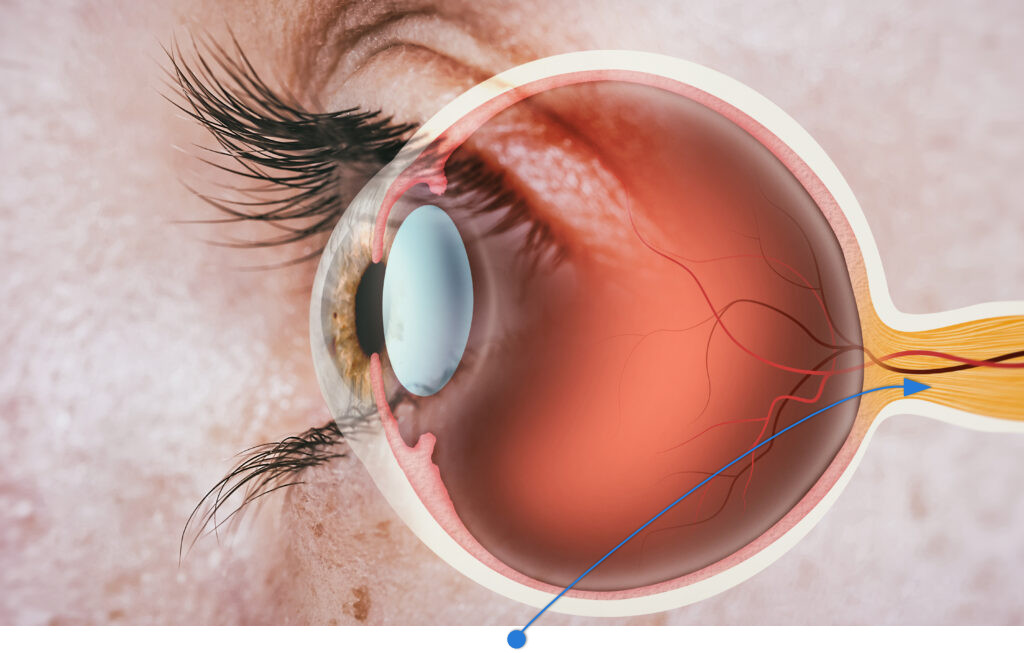The glaucoma.
Glaucoma is a syndrome of optic nerve damage associated with elevated intraocular pressure (IOP) in most cases. This high eye pressure is mostly painless. Sometimes glaucoma (damage to the optic nerve) can occur with IOP within what is considered normal range, called normotensive glaucoma.
The main symptom caused by glaucoma is a loss of visual field, that is, a narrowing of the area that our eyes allow us to see. The diagnosis is made through an ophthalmological examination that requires an exhaustive examination of different structures of the eye, in addition to taking eye pressure (IOP). The treatment of glaucoma involves the use of topical medications (eye drops), laser or even surgery depending on its characteristics and the patient’s risk of visual loss.

What is the Optic Nerve?
The optic nerve is made up of more than one million small nerve fibers. It is similar to an electrical cable made up of many very thin fibers. When these nerve fibers die, blind spots in vision (visual field loss) develop. The patient with visual field loss would have a sensation similar to the image at the beginning of this section. He may not notice these blind spots until most of the optic nerve fibers have died. For the above reason, it is advisable to have your eye pressure checked after age 45, especially if you have a family history of glaucoma or high eye pressure.
There are two main types of glaucoma.
Chronic open angle glaucoma
This is the most common type of glaucoma. It occurs gradually, when the eye does not adequately control its intraocular pressure and it increases. As a result, the optic nerve is damaged. This type of glaucoma is not painful and does not cause any changes in vision at first. For the above reason, it is advisable to have your eye pressure checked after age 45, especially if you have a family history of glaucoma or high eye pressure.
Angle-closure glaucoma (narrow-angle or pupillary block glaucoma)
This type occurs when a person’s iris is very close to the drainage angle in the eye. The iris can block the drainage angle completely, and consequently eye pressure increases rapidly. This is called acute glaucoma. This is a true eye emergency and you should call the ophthalmologist immediately; Otherwise, he could go blind.
How to recognize it?
The most frequent symptoms:
- You have severe pain in your eye and in the frontal region (above your eyebrow) and around your eye.
- Vision suddenly becomes blurry.
- He has stomach pain with a feeling of nausea, and even vomits.
Does glaucoma have treatment?
The treatment of glaucoma involves the use of topical medications (eye drops), laser or even surgery depending on its characteristics and the patient’s risk of visual loss. If you have been diagnosed with glaucoma, suspect you have it, or have a family history, do not hesitate to make an appointment for a complete examination. If necessary, the treatment that best suits your situation will be proposed.
How to recognize it?
The most frequent symptoms:
- You have severe pain in your eye and in the frontal region (above your eyebrow) and around your eye.
- Vision suddenly becomes blurry.
- He has stomach pain with a feeling of nausea, and even vomits.
Does glaucoma have treatment?
The treatment of glaucoma involves the use of topical medications (eye drops), laser or even surgery depending on its characteristics and the patient’s risk of visual loss. If you have been diagnosed with glaucoma, suspect you have it, or have a family history, do not hesitate to make an appointment for a complete examination. If necessary, the treatment that best suits your situation will be proposed.

